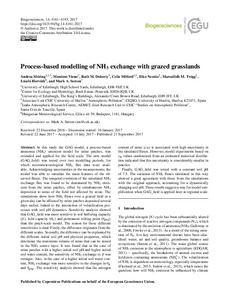Por favor, use este identificador para citar o enlazar este ítem:
http://hdl.handle.net/20.500.11765/11532
Process-based modelling of NH3 exchange with grazed grasslands
| Título : | Process-based modelling of NH3 exchange with grazed grasslands |
| Autor : | Móring, Andrea; Vieno, Massimo; Doherty, Ruth M.; Milford, Celia
 ; Nemitz, Eiko; Twigg, Marsailidh M.; Horváth, László; Sutton, Mark A.
; Nemitz, Eiko; Twigg, Marsailidh M.; Horváth, László; Sutton, Mark A. |
| Palabras clave : | GAG model; Global nitrogen cycle; Measurements |
| Fecha de publicación : | 2017 |
| Editor: | European Geosciences Union |
| Citación : | Biogeosciences. 2017, 14(18), p. 4161–4193 |
| Versión del editor: | https://dx.doi.org/10.5194/bg-14-4161-2017 |
| Resumen : | In this study the GAG model, a process-based ammonia (NH3) emission model for urine patches, was extended and applied for the field scale. The new model (GAG_field) was tested over two modelling periods, for which micrometeorological NH3 flux data were available. Acknowledging uncertainties in the measurements, the model was able to simulate the main features of the observed fluxes. The temporal evolution of the simulated NH3 exchange flux was found to be dominated by NH3 emission from the urine patches, offset by simultaneous NH3 deposition to areas of the field not affected by urine. The simulations show how NH3 fluxes over a grazed field in a given day can be affected by urine patches deposited several days earlier, linked to the interaction of volatilization processes with soil pH dynamics. Sensitivity analysis showed that GAG_field was more sensitive to soil buffering capacity (β), field capacity (θfc) and permanent wilting point (θpwp) than the patch-scale model. The reason for these different sensitivities is dual. Firstly, the difference originates from the different scales. Secondly, the difference can be explained by the different initial soil pH and physical properties, which determine the maximum volume of urine that can be stored in the NH3 source layer. It was found that in the case of urine patches with a higher initial soil pH and higher initial soil water content, the sensitivity of NH3 exchange to β was stronger. Also, in the case of a higher initial soil water content, NH3 exchange was more sensitive to the changes in θfc and θpwp. The sensitivity analysis showed that the nitrogen content of urine (cN) is associated with high uncertainty in the simulated fluxes. However, model experiments based on cN values randomized from an estimated statistical distribution indicated that this uncertainty is considerably smaller in practic |
| Patrocinador: | This work was carried out within the framework of the ÉCLAIRE project (Effects of Climate Change on Air Pollution and Response Strategies for European Ecosystems) funded by the EU’s Seventh Framework Programme for Research and Technological Development (FP7) and with matching National Capability funds from the UK Natural Environment Research Council through the Centre for Ecology and Hydrology. |
| URI : | http://hdl.handle.net/20.500.11765/11532 |
| ISSN : | 1726-4170 1726-4189 |
| Colecciones: | Artículos científicos 2015-2018 |
Ficheros en este ítem:
| Fichero | Descripción | Tamaño | Formato | ||
|---|---|---|---|---|---|
| bg-14-4161-2017.pdf | 965,28 kB | Adobe PDF |  Visualizar/Abrir |
Los ítems de Arcimis están protegidos por una Licencia Creative Commons, salvo que se indique lo contrario.





